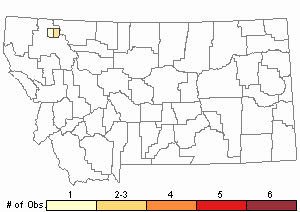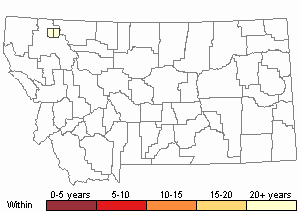View in other NatureServe Network Field Guides
NatureServe
Montana
Utah
Wyoming
Idaho
Wisconsin
British Columbia
South Carolina
Yukon
California
New York
Pale Windblown Moss - Paraleucobryum longifolium
Other Names:
Longleaf Paraleucobryum Moss
General Description
Plants: Acrocarpous. Growing in open to crowded clumps of erect shoots, green with white or grey tinges, or more yellow, less deeply colored below, shiny. Stems 1-7 cm in height; rhizoids intermingling with leaves on the stems (FNA 2007).
Leaves: Spreading to ca 45 degrees and occasionally straight to typically curved in sickle-like fashion and pointing toward one side of the stem, particularly at the top of the stem, smooth, similar in dry and moist conditions (FNA 2007), narrowly lance-shaped and subulate, nearly tubulose above (Crum & Anderson et al., 1981) to an acute leaf tip which occasionally falls away, 4-8 mm in length, 0.2-0.8 mm in width (FNA 2007); leaf edges typically finely saw-toothed from tip to mid-leaf or as far as the shoulders (Crum & Anderson et al., 1981); costa extending to the leaf tip, at the leaf bottom ca half or more of the leaf width, with lines running along its length on the dorsal surface, more prominent above, like ridges of small teeth under strong magnification (FNA 2007).
Leaf Cells: Lamina of 1 cell-layer, the cells smooth, porose below; median laminal cells square to quadrangular, longer proximally; alar cells usually brown, otherwise hyaline, swollen, reaching the costa, the alar region 1 cell-layer thick; costa in X-section with (green) chlorophyllous cells sandwiched between ventral and dorsal hyalocysts, a few green cells intermingling with the ventral hyalocysts (FNA 2007).
Phenology
Fruit ripens in summer (FNA 2007).
Range Comments
North American Range
AK, NT, BC to NL and NS (except SK), CO, AZ and NM, MT, SD, MN to MI, northeastern and eastern coastal states w to OH, WV, and TN, also AL (FNA 2007). Known in MT from Flathead County (Elliott & Pipp, 2016).
Observations in Montana Natural Heritage Program Database
Number of Observations: 4
(Click on the following maps and charts to see full sized version)
Map Help and Descriptions
Relative Density

Recency


 (Observations spanning multiple months or years are excluded from time charts)
(Observations spanning multiple months or years are excluded from time charts)
Habitat
Soil and stone in alpine areas (Lawton 1971), soil overlying large rocks and bluffs, occasionally on decaying wood. Elevation: 1310-9510 feet (FNA 2007).
Reproductive Characteristics
Dioicous. Perigonial bracts cupped, egg-shaped, narrowing to a short acumen; perichaetial bracts wide below, long-awned. Sporophytes common. Seta usually single, spiraled when dry, 8-20 mm in length. Capsule vertical or slightly tilted, 1.5-3 mm in length (FNA 2007), ochre, sometimes slightly creased when dry (Lawton 1971); peristome with 16 2-lobed teeth, the lobes reaching to mid-tooth, russet, with longitudinal or slanted grooves below and papillae above. Calyptra is like a draping hood, smooth, shielding the majority of the capsule, falling away (FNA 2007).
Stewardship Responsibility
References
- Literature Cited AboveLegend:
 View Online Publication
View Online Publication Crum, H.A. and L.E. Anderson. 1981. Mosses of Eastern North America. 2 volumes. Columbia University Press, New York. 1328 pp.
Crum, H.A. and L.E. Anderson. 1981. Mosses of Eastern North America. 2 volumes. Columbia University Press, New York. 1328 pp. Elliott, J.C. and A.K. Pipp. 2018. A Checklist of Montana Mosses (1880-2018). Updated 3 January, 2020. Montana Natural Heritage Program, Helena, Montana. 73 pp.
Elliott, J.C. and A.K. Pipp. 2018. A Checklist of Montana Mosses (1880-2018). Updated 3 January, 2020. Montana Natural Heritage Program, Helena, Montana. 73 pp. Flora of North America Editorial Committee, eds. 2007. Flora of North America North of Mexico. Volume 27. Bryophytes: Mosses, Part 1. Oxford University Press, Inc., NY. xxi + 713 pp.
Flora of North America Editorial Committee, eds. 2007. Flora of North America North of Mexico. Volume 27. Bryophytes: Mosses, Part 1. Oxford University Press, Inc., NY. xxi + 713 pp. Lawton, E. 1971. Moss Flora of the Pacific Northwest. Hattori Botanical Laboratory. Japan: Yamabuki-cho, Shinjuku-ku, Tokyo. 362 pages plus appendices.
Lawton, E. 1971. Moss Flora of the Pacific Northwest. Hattori Botanical Laboratory. Japan: Yamabuki-cho, Shinjuku-ku, Tokyo. 362 pages plus appendices.
- Additional ReferencesLegend:
 View Online Publication
View Online Publication
Do you know of a citation we're missing? Elliot, J. C. 1993. Second checklist of Montana mosses. Unpublished report. U.S. Forest Service, Region 1. Missoula, MT. 45 pp.
Elliot, J. C. 1993. Second checklist of Montana mosses. Unpublished report. U.S. Forest Service, Region 1. Missoula, MT. 45 pp. Lawton, E. 1971. Keys for the Identification of the Mosses on the Pacific Northwest. Reprinted from 'Moss Flora of the Pacific Northwest'. Published as Supplement No. 2 of the Journal of the Hattori Botanical Laboratory. Nichinan, Miyazaki, Japan. 66 pp.
Lawton, E. 1971. Keys for the Identification of the Mosses on the Pacific Northwest. Reprinted from 'Moss Flora of the Pacific Northwest'. Published as Supplement No. 2 of the Journal of the Hattori Botanical Laboratory. Nichinan, Miyazaki, Japan. 66 pp. Smith, A.J.E. 1980. The Moss Flora of Britain and Ireland. Cambridge University Press, Cambridge. 705 pp.
Smith, A.J.E. 1980. The Moss Flora of Britain and Ireland. Cambridge University Press, Cambridge. 705 pp.
- Web Search Engines for Articles on "Pale Windblown Moss"





